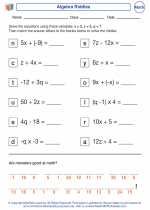Introduction to Algebra
What is Algebra?
Algebra is a branch of mathematics in which letters and symbols are used to represent numbers and quantities in formulas and equations. It allows us to solve mathematical problems by using variables and operations.
Basic Concepts in Algebra
1. Variables: In algebra, letters such as x, y, and z are used to represent unknown quantities or values.
2. Expressions: An algebraic expression is a combination of variables, constants, and operations (like addition, subtraction, multiplication, and division).
3. Equations: An equation is a mathematical statement that shows the equality of two expressions. It typically contains an equal sign (=).
4. Terms: In an algebraic expression, terms are the parts separated by the addition or subtraction signs.
5. Coefficients: The coefficient of a term is the numerical factor that is multiplied by the variable.
Operations in Algebra
1. Addition and Subtraction: In algebra, we add or subtract like terms by combining the coefficients of the same variables.
2. Multiplication and Division: We use multiplication and division to simplify algebraic expressions and solve equations.
Study Guide
To understand and excel in algebra, it's important to practice various problems and concepts. Here's a study guide to help you get started:
- Learn the basic vocabulary and concepts of algebra, such as variables, expressions, and equations.
- Practice simplifying algebraic expressions by combining like terms and using the order of operations.
- Understand how to solve simple equations and inequalities.
- Work on word problems involving algebraic expressions and equations.
- Practice using algebra to represent real-life situations and solve problems related to geometry, physics, and more.
Remember, practice is key to mastering algebra. As you become more familiar with the concepts and operations, you'll gain confidence and improve your problem-solving skills.
[Introduction To Algebra] Related Worksheets and Study Guides:
.◂Math Worksheets and Study Guides Seventh Grade. Introduction to Algebra
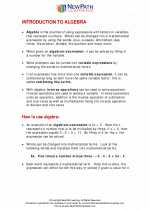
 Activity Lesson
Activity Lesson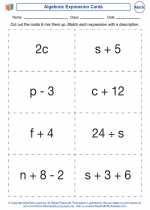
 Worksheet/Answer key
Worksheet/Answer key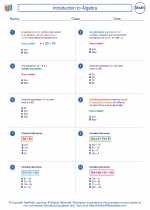
 Worksheet/Answer key
Worksheet/Answer key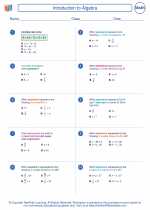
 Worksheet/Answer key
Worksheet/Answer key
 Worksheet/Answer key
Worksheet/Answer key